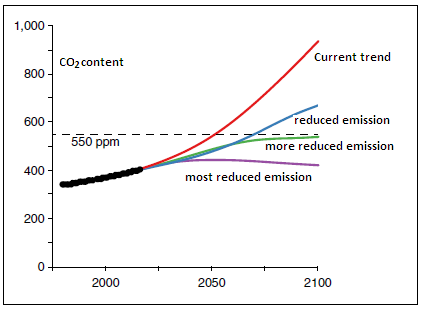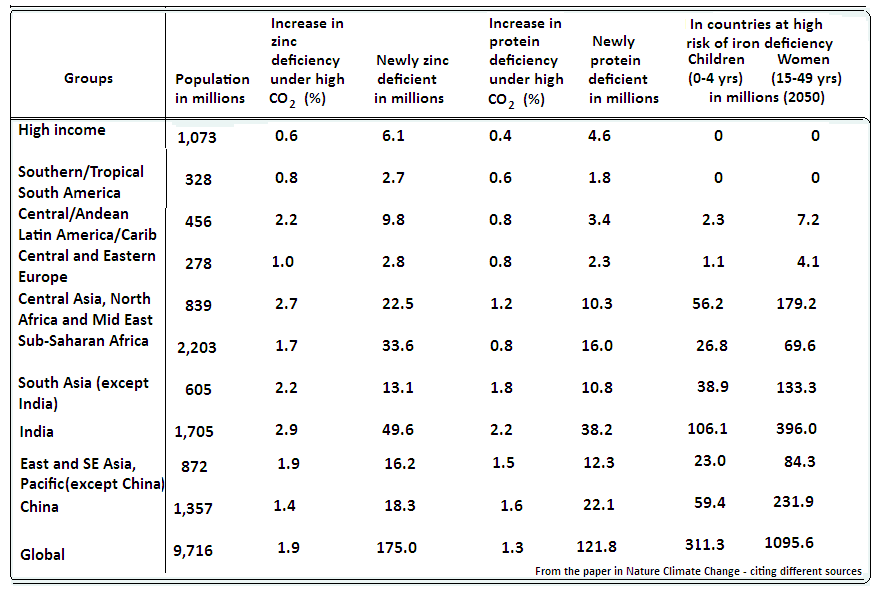Rising CO2 levels in the atmosphere would depress nutrients in food crops, says S.Ananthanarayanan.
The 21st century is set to see rising levels of carbon the in the atmosphere. The atmospheric CO2 content is now 410 parts per million, a rise from 280 ppm in mid 18th century and 300 ppm in 1950. While the governments of the world have got together to limit release of CO2 by cities and by industry, the rise is expected to continue till the end of the century. Human population, which would keep increasing for most of this period, would compound the problem by greater demand for food and increasing pressure on land use.
Matthew R. Smith and Samuel S. Myers from the Harvard T.H. Chan School of Public Health, at Boston, and the Harvard University Center for the Environment, write in the journal, Nature Climate Change, that apart from shortages of food and the land to grow food, the rising CO2 levels would affect vital nutritional components of food crops. The most vulnerable populations of the world, which depend on vegetarian sources, would face a double challenge of shortage of food and depleted quality. The data that the study reports puts the spotlight on India as the leader in conditions that need urgent attention
The current emission levels from fossil fuels and the changes in land use, worldwide, are expected to take CO2 levels to a disastrous 940 ppm by the century end. Mitigation measures that are proposed and may be implemented would lead to slower rise of CO2, as shown in the graph. But, as we can see, all programmes, except the most ambitious one, would lead to a CO2 level of 550 ppm. For the purpose of the present study, of the effect of CO2 on nutrients in food crops, the paper takes it that the rise in CO2 would follow the current trajectory, and reach the level of 550 ppm by the year 2050.

Experimental trials have been carried out, with food crops that are grown in open field, both under ambient conditions and under conditions where CO2 levels s are at about 550 ppm, the paper says. The trials reveal that in many important crops, the concentration of protein, iron and zinc falls by some 3–17%. The paper says that for most of these important nutrients, for humans worldwide, is plant based food. As much as 63% of dietary protein, 81% of iron and 68%of zinc, the paper says, come from vegetal sources. There is already severe nutritional deficiency, worldwide - over two billion people are estimated to be deficient in at least one essential nutrient. This is a condition that has cascading implications, of poor health, rising medical costs and low productivity. A fall in the nutritional content of plant based food would hence exacerbate the problems, of which the third world would bear the greatest brunt.
In order to assess the impact of climate change and elevated CO2, the current study has integrated the best available estimates of population growth, physiological nutritional requirements and future diets. The effect on the nutrient content of a large number of kinds of food, 225 kinds, against 98 used in earlier studies, has then been modeled. Age and sex – specific data sets have been used and data from sources selected to enable comparison and analysis. “With the enhancement and harmonization of datasets and assumptions, we have attempted to provide the most accurate synthesis of the global health burden from elevated CO2-related nutrient shifts in crops,” the paper says.
The results of the study are summarized in the table:

We can see that India leads in the rise in deficiency, followed by China. Latin America, Central Asia, North and sub Saharan Africa and the rest of Asia are not far behind. The effect is to add to the pressures on the areas that are already under the highest stress. Apart from impaired productivity and higher health care costs, are the human costs of infant and premature, diet-related adult mortality. The economic impact, according to ‘Global Impact’, an independent group of experts, comes to US$ 3.5 trillion per year, or US$ 500 per individual, worldwide
The findings also underline another area of adaptation to climate change for many areas. The study notes that the diets and health of global populations are changing rapidly. Nutrition experts and planners need to take the effects of enhanced CO2 on the nutritional value of plant foods into account and influence choices to reduce impact.
An extract from the paper
“..India has shown inconsistent gains in addressing undernutrition and nutritional deficiencies. Despite significant progress in reducing the rate of underweight children since 1990, Indian children still have the fourth worst global weight-for-age scores (the standard measure for underweight), and nearly 35% of Indian children continue to meet the criteria for being underweight, far above the developing country average of 20%. Meanwhile, India has seen significant progress in reducing the burden of anaemia, decreasing the number of years lost to disability from anaemia by 28% between 1990 and 2015. However, the prevalence of inadequate zinc intake has increased over much of that same timeframe from 28 to 31% between 1990 and 2005. In contrast, China actively targeted improvements in child nutrition over the same period, reducing its undernourished rate from 24 to 9% between 1991 and 2015. It also decreased its years lost to disability caused by anaemia by 30% between 1990 and 2015, and reduced its rate of inadequate zinc intake from 17 to 8% between 1990 and 2005.”
------------------------------------------------------------------------------------------ Do respond to : response@simplescience.in